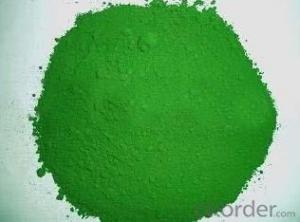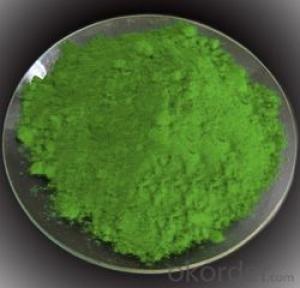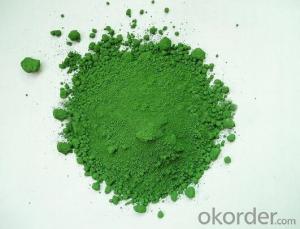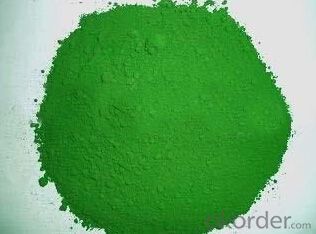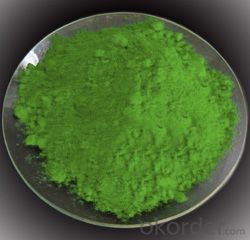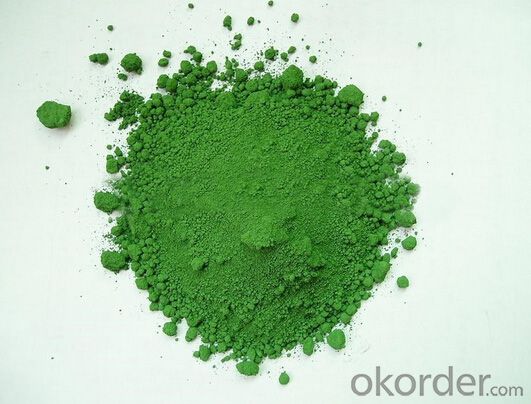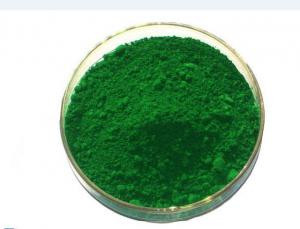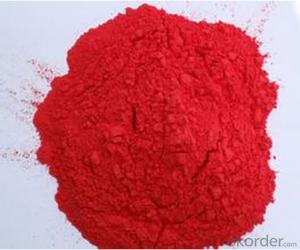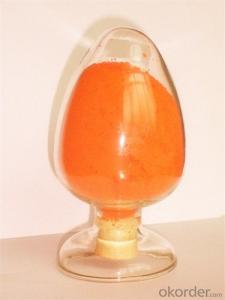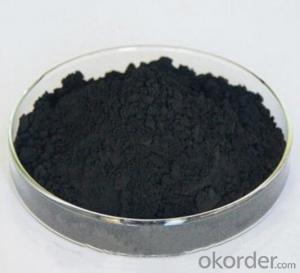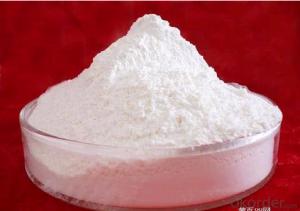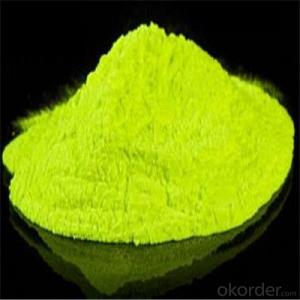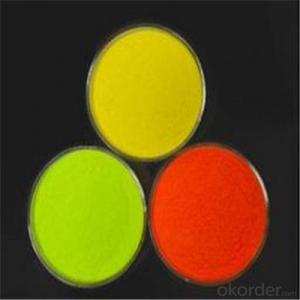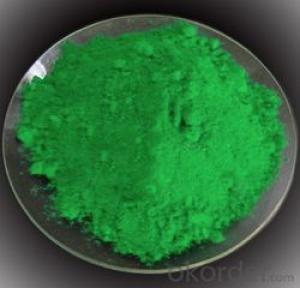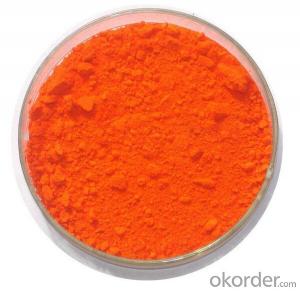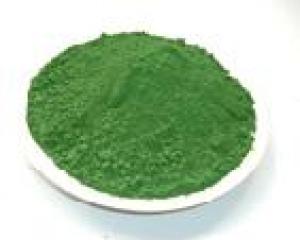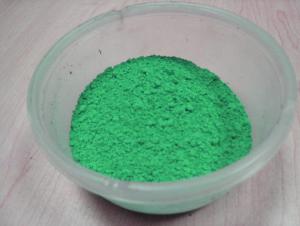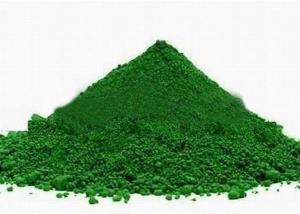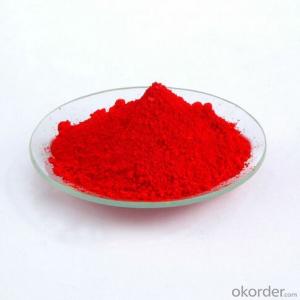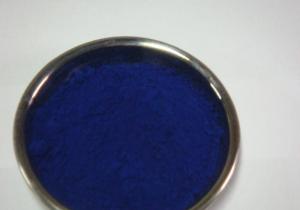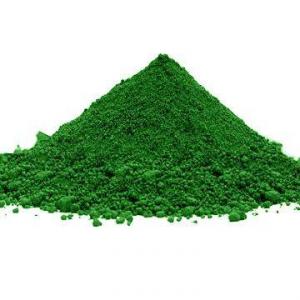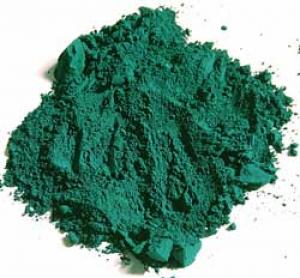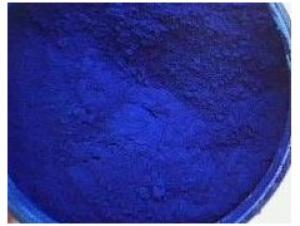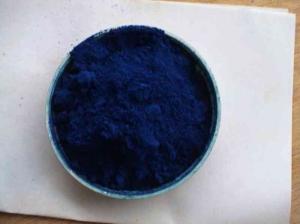Chrome Green Pigment Organic Pigment Powder
- Loading Port:
- Tianjin
- Payment Terms:
- TT OR LC
- Min Order Qty:
- 500 kg
- Supply Capability:
- 6000000 kg/month
OKorder Service Pledge
OKorder Financial Service
You Might Also Like
Chrome Green Specification:
Standard: HG/T2775-2010
Items | Specifications |
Cr2O3 Content % | 99.0 min |
Moisture % | 0.20 max |
Water soluble matter % | 0.30 max |
Oil absorption (g/100g)% | 15-25g/100g |
Tinting strength % | 100+/-5 |
Residue on 325mesh) % | 0.10 max |
sexivalent chrome content% | 0.005 max |
PH Value (100g/L suspension liquid)% | 6-8 max |
Color/Appearance | Green powder |
Chrome Green Chemical and Physical Properties:
Product name: Chrome Oxide Green
Appearance: Light or dark green powder
EINECS NO.: 215-160-9
CAS No.:1308-38-9
HS.Code:2819900000
Molecular Formula: Cr2O3
Properties:Chrome green is a green crystal powder, metal luster, magnetic, good covering strength, high-temperature-resisting and sunlight fastness. Not soluble in water, barely soluble in acids, comparatively stable in air, unaffected by acids and alkalis of common density, sulfur dioxide, sulfur hydrogen etc. Chrome oxide green enjoys excellent quality and firmness of coloring.
Chrome Green Applications:
Chrome green is used in smelting of metal chrome, as coloring agent of chrome carbide, enamel, glass, artificial leather and building material, as organic synthetic catalyst, in making of sunlight fastness coatings, special printing ink for paper money, making of polishing ointment and abrasive etc.
Chrome Green Package:
Chrome green is packed in 25kgs, 50kgs woven bags lined with PE liner or as request.
20-24MT will be loaded in per 20’FCL container.
Chrome Green Attention and Storage:
Chrome green shoud be stored in an airtight container, in a cool, ventilated place or specified place; Avoid taboo things.


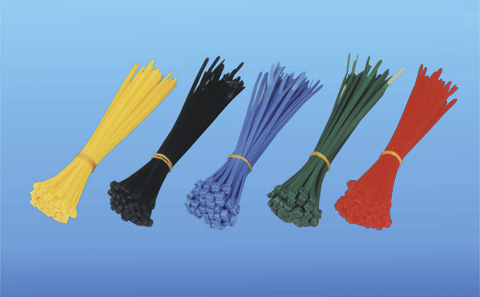
- Q: thank you very much for your help!
- Well photosynthetic pigments has to do with the different component of light (i.e. the colors - ROYGBIV) and their specific wavelenght. Photosynthetic pigments based on their colors can capture the energy from that wavelenght. For example fucoxanthin can capture the brown color of the light just like phycocyanin can capture the blue color of the light. These photosynthetic pigments are usually the accessory pigments of Chlorophyll A which is the main pigments of most of the photosynthetic organisms in the earth.
- Q: A.catalyzes chemical reactions.B.absorbs light.C.transports materials.D nverts energy to light.E s energy.
- B. It absorbs light.
- Q: list 5 mineral pigments and 5 animals pigments and how its produced
- Mineral Pigments: Lazurite (Lapis Lazuli), Vivianite (Blue Ochre), Riebeckite, Glauconite, Malachite, Jarosite, Limonite, Hematite, Goethite, Celadonite and Shungite Animal Pigments: Tyrian Purple, made from the mucus of a Murex snail Carmine, made from an insect in central and south America, called Cochinilla Natural indigo, made from plants of the genera Indigofera Rose madder, a pigment derived from the plant Rubia tinctorum Gamboge, I think is a dark type of mustard (seeds) Alizarin occurs in the root of the common madder (Rubia tinctorum) and in various parts of Indian madder (Rubia cordifolia). And regarding how they are produced, well each one has it?s own methods. You may want to search each of those names and you can find information for each one. Hope this helps, Bella
- Q: i need pigment in powdered form and i need it to be oil based for my resin project. i was thinking about just crushing up artist oil pastels but i need it to be really fine with no chunks. sooo, i was wondering if anyone sells really fine oil based art pigment powders in a variety of colors. or do you know of i way i could crush up the pastels super fine so it will mix evenly into the resin? (i hope this made sence, i don't know much about art lol)thanks!!!:)
- Hi. okorder /... Those are all pure pigments, no hues or imitations. The prices may seem high, but even a half a pound of pigment is a huge amount. Prices I've seen on other sites are higher. I do not think it will work to crush up pastels, oil or otherwise, because they already have a binder and probably a lot of filler in them -- you will get a very weak color. Hope this helps.
- Q: I am about to purchase a bunch of MAC pigments and I have noticed that they all look glittery, is this just the kind that i am looking at? I know they are versatile, so that is why i want to buy them. And it seems as though they will last longert than eyeshadow...
- Of course they can ! I love mac pigments. Yes, fallout is involved..but what i do is i use my mixing medium with them so that they go on wet and no fallout. If you don't have mixing medium you can mix them with eyedrops. What i do is i put a drop in the lid and pick up some pigment and mix it till i get the perfect consistancy. You can also learn how to press them, so that they can become pressed eyeshadows instead of loose. But if you just want to use them loose, make sure you get a good flat shader brush...make sure you pat the pigment on your lids insted of in a swiping motion, this also prevents less fall out. Get some loose transparent powder as well set that under your eyes, and swipe it off when done..this makes the fallout swipe away without smearing on your face.. Hope that helps ! If you want you can do all of this, but you don't have to...just random tips to prevent that annoying fallout
- Q: What is the role of pigment in photosynthesis photosynthesis ?
- Photosynthesis can't happen without the pigment chlorophyll (which is green and is why leaves and stuff are green). Chlorophyll is found in chloroplasts, an organelle in plant cells. Chlorophyll harnesses the sunlight's energy in order to split water (into hydrogen pairs and oxygen) so it can be used in the photosynthesis process (ie. in order to make glucose, the food source for plants). Hope this helps! :D
- Q: can pigment ink be used to tattoo?
- Pigment ink? Tattoo ink is pigment ink. Printer ink is pigment ink. Crayola markers are pigment ink. It all comes down to what it's manufactured for and whom is doing the manufacturing. Reputable shops use certain brands of tattoo ink for a reason. Using something not made for the human body at all makes for an ugly tattoo and can cause infections or other problems seeing as nothing in it's manufacturing process is sanitary or compatible with use in skin.
- Q: I got this question from my A2 Biology but I can't find the answer. Does anybody know?
- Photosynthesis in plants is dependent upon capturing light energy in the pigment chlorophyll, and in particular chlorophyll a. This chlorophyll resides mostly in the chloroplasts and gives leaves their green color. The range of light absorption in leaves is extended by some accessory pigments such as the carotenoids, but does not cover the entire visible range - that would make the leaves black! Some plants and plantlike organisms have developed other pigments to compensate for low light or poor use of light. Cyanobacteria and red algae have phycocyanin and allophycocyanin as accessory pigments to absorbe orange light. They also have a red pigment called phycoerythrin that absorbs green light and extends the range of photosynthesis. The red pigment lycopene is found in vegetables. Some red algae are in fact nearly black, so that increases their photosynthetic efficiency. Brown algae have the pigment fucoxanthin in addition to chlorophyll to widen their absorption range. These red and brown algae grow to depths around 270 meters where the light is less than 1% of surface light. Chlorophylla-a is the primary pigment for photosynthesis in plants. Its structure is shown at left. It has the composition C55H72O5N4Mg. It exhibits a grass-green visual color and absorption peaks at 430nm and 662nm. It occurs in all photosynthetic organisms except photosynthetic bacteria. Chlorophyll-b has the composition C55H70O6N4Mg, the difference from chlorophyll-a being the replacement of a methyl group with a CHO. It exhibits a blue-green visual color and absorption peaks at 453nm and 642nm. It occurs in all plants, green algae and some prokaryotes. There is usually about half as much chlorophyll-b as the -a variety in plants.
- Q: If they are not the same, then what is the difference? Please help me out here.
- Yes, tannins are pigments but they aren't really the main plant pigment. Plant pigments usually refer to photosynthetic pigments (chlorophyll, carotenoids, etc.). These photosynthetic pigments give the leaves their green color (or yellow/orange in the fall). Tannins are non-photosynthetic phytochemical (involved in plant metabolism and internal functioning), but they are also a pigment. Tannins (and lignins) are brown. This is was gives dead leaves and wood their color. Tannins also leach out of the leaves when soaked in water (same process as brewing a cup of tea). So tannins are pigments when they leach out of leaves and stain water (or other things) brown, but they are not photosynthetic plant pigments. In other words, it depends on what context you are calling a tannin a pigment. In a live plant they are not a pigment (judgment call here). In a dead leaf or when they leach out of a leaf they are a pigment.
Send your message to us
Chrome Green Pigment Organic Pigment Powder
- Loading Port:
- Tianjin
- Payment Terms:
- TT OR LC
- Min Order Qty:
- 500 kg
- Supply Capability:
- 6000000 kg/month
OKorder Service Pledge
OKorder Financial Service
Similar products
Hot products
Hot Searches
Related keywords
